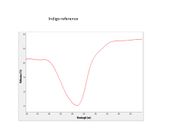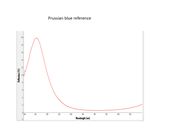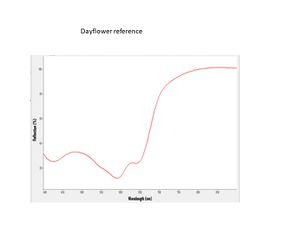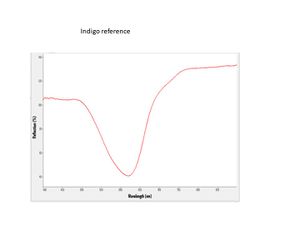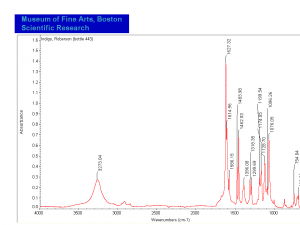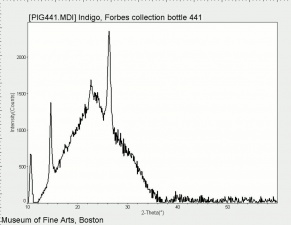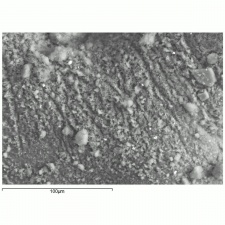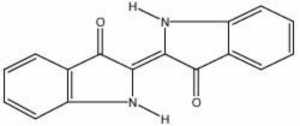Difference between revisions of "FORS analysis of Ukiyo-e prints"
| Line 20: | Line 20: | ||
|- | |- | ||
|[[[SliderGallery Leftalign|Dayflower FORS.JPG~Dayflower|Indigo FORS.JPG~Indigo|Prussian blue FORS.jpg~Prussian blue]]] | |[[[SliderGallery Leftalign|Dayflower FORS.JPG~Dayflower|Indigo FORS.JPG~Indigo|Prussian blue FORS.jpg~Prussian blue]]] | ||
| − | |[[[SliderGallery center|Malachite FORS.png~Malachite|Orpiment-Indigo FORS.png~Orpiment/Indigo|Orpiment-Prussian blue FORS.png~Orpiment/Prussian Blue|Turmeric-Dayflower FORS.png~Turmeric/Dayflower|Verdigris FORS.png~Verdigris]]] | + | |[[[SliderGallery center|Malachite reference FORS.png~Malachite|Orpiment-Indigo FORS.png~Orpiment/Indigo|Orpiment-Prussian blue FORS.png~Orpiment/Prussian Blue|Turmeric-Dayflower FORS.png~Turmeric/Dayflower|Verdigris FORS.png~Verdigris]]] |
|[[[SliderGallery center|Indigo(443).PNG~FTIR (MFA)|Indigo, Forbes (MFA 443), 785nm.TIF~Raman (MFA)|PIG441.jpg~XRD|f441sem.jpg~SEM|f441edsbw.jpg~EDS|Indigo_FORS.JPG~FORS|indigo.jpg~Chemical structure]]] | |[[[SliderGallery center|Indigo(443).PNG~FTIR (MFA)|Indigo, Forbes (MFA 443), 785nm.TIF~Raman (MFA)|PIG441.jpg~XRD|f441sem.jpg~SEM|f441edsbw.jpg~EDS|Indigo_FORS.JPG~FORS|indigo.jpg~Chemical structure]]] | ||
|[[[SliderGallery center|Indigo(443).PNG~FTIR (MFA)|Indigo, Forbes (MFA 443), 785nm.TIF~Raman (MFA)|PIG441.jpg~XRD|f441sem.jpg~SEM|f441edsbw.jpg~EDS|Indigo_FORS.JPG~FORS|indigo.jpg~Chemical structure]]] | |[[[SliderGallery center|Indigo(443).PNG~FTIR (MFA)|Indigo, Forbes (MFA 443), 785nm.TIF~Raman (MFA)|PIG441.jpg~XRD|f441sem.jpg~SEM|f441edsbw.jpg~EDS|Indigo_FORS.JPG~FORS|indigo.jpg~Chemical structure]]] | ||
Revision as of 17:02, 24 April 2025
Overview
Fiber Optics Reflectance spectroscopy (FORS) measures the reflectance of a point on an object across the visible and near infrared region (about 400-1000 nm). FORS uses a fiber optic probe and a high intensity halogen light source to examine very small spots, minimizing the interference from ambient light. For this research, an Ocean Optics miniature spectrometer was used.
Reflectance spectra can distinguish between some colorants. For example, the three common blue colorants used in Japanese woodblock prints (dayflower, indigo, and Prussian blue) can be easily identified by FORS. Greens were usually made from a combination of a blue and a yellow colorant, while purples were usually made from a combination of a blue and a red colorant. The blue colorants in these mixtures can usually be determined by FORS analysis. FORS is not usually useful for identifying yellow colorants, but can sometimes be useful for the organic reds.
Reflectance spectra for the three common blues are show below, along with spectra of each blue from a print. The paper used in the prints typically has a slight yellowish tint, thus for the FORS analysis, an area of bare paper is used to acquire a background spectrum, which is then subtracted from the spectrum of the colored area. In principal, this gives spectra which should be more directly comparable between standards prepared in the lab and areas on prints.
FORS Reference Spectra
| Blues | Greens | Yellows | Reds |
|---|---|---|---|
|
|
|
|


